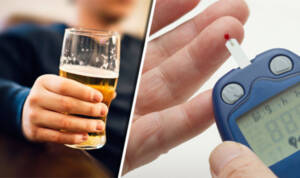Diabetes can be a challenging condition to manage. Despite its prevalence, there are many myths and misconceptions surrounding it. Debunking these myths is crucial for individuals with diabetes for a better understanding of the condition, make informed dietary choices and manage their blood sugar levels. In this article, we’ll debunk some common myths about diabetes.
Myth: Many of my family members have diabetes. It’s in my genes. There’s nothing I can do to prevent it.
Fact: Although heredity is a risk factor for diabetes, it is possible to prevent or delay the onset of type 2 diabetes by adopting healthy lifestyle habits including diet and exercise.
Myth: I have a sweet tooth, so I am at risk of developing diabetes later!
Fact: Type 2 diabetes is caused by an inability of the pancreas to make enough insulin or if there is a problem with how the insulin is used by the cells. Risk factors for Type 2 diabetes include genetics and lifestyle issues like being overweight, obese, overall dietary habits and sedentary lifestyle. Eating too much sugary foods does not cause diabetes. However, the chances of developing diabetes are greater as diets high in sugar are often a high in calories too and excess calories can lead to weight gain.
Myth: Having diabetes means your body isn’t producing enough insulin.
Fact: Having diabetes doesn’t necessarily mean that your body isn’t producing enough insulin. While some people with diabetes have an insulin production deficiency, others may have insulin resistance where the body still produces insulin, but it may not use it effectively. In a healthy individual, when you consume carbohydrates, your digestive system breaks them down into glucose, which enters the bloodstream. In response to rising blood sugar levels after a meal, the pancreas releases insulin. Insulin acts as a “key” that allows glucose to enter cells. Once inside the cells, glucose is used for energy or stored for future use. In individuals with insulin resistance, the body’s cells, particularly muscle, fat, and liver cells, do not respond well to the signals sent by insulin. As a result, glucose has difficulty entering these cells, leading to elevated blood sugar levels.
Myth: Prediabetes Always Leads to Diabetes
Fact: Prediabetes is a condition characterized by elevated blood sugar levels that are not yet in the diabetes range. It serves as a warning sign that individuals are at higher risk for developing type 2 diabetes, but it doesn’t mean diabetes is inevitable. Research has shown that adopting a healthy lifestyle, including regular physical activity, dietary improvements, losing weight and maintaining a healthy body weight can significantly reduce the risk of progressing from prediabetes to diabetes.
Myth: People with Diabetes Can’t Eat Carbohydrates
Fact: While it’s true that carbohydrates can raise blood sugar levels, it’s a misunderstanding to think that people with diabetes cannot consume them. People with diabetes typically should be eating the same diet as anyone else –high in vegetables, fruits, fiber, whole grain, lean meats, and heart healthy fats. Carbohydrates are one of the three main macronutrients (along with proteins and fats), and they provide a critical source of energy for the body. The key is to monitor and manage carbohydrate intake effectively. This can be done through portion control, selecting complex carbohydrates (such as whole grains, millets like jowar, bajra, ragi, legumes, vegetables) over simple sugars, and spacing out carbohydrate consumption throughout the day. Portion control and monitoring blood sugar levels are also essential strategies for carbohydrate management. Restricting carbohydrates excessively can lead to an imbalanced diet and nutrient deficiencies.
Myth: You can’t eat any sweets if you have diabetes.
Fact: While it’s essential to limit the consumption of sugary foods and beverages, you don’t need to eliminate them entirely. Occasional indulgences are acceptable, but they should be consumed in moderation and as part of an overall balanced diet. You can eat small amount of sweet in place of other carbohydrates usually eaten at a meal and eat them with protein, fibre-rich foods, and healthy fats, to help stabilize blood sugar levels. It’s important to monitor blood sugar levels and adjust insulin or medications as needed to manage occasional indulgences.
Myth: People with diabetes can eat jaggery, honey, maple syrup and brown sugar instead of white sugar.
Fact: While jaggery, honey, maple syrup, and brown sugar may have slightly different properties compared to white sugar, they are not necessarily healthier or significantly better for individuals with diabetes. Calories from all these sweeteners are almost the same and consuming any of these can still raise blood sugar levels. Although jaggery and honey contain nutrients, such as vitamins, minerals or antioxidants, the amounts consumed are so small that their health impact is minimal.
Myth: “As long as it is whole wheat pasta, I can eat all I want.”
Fact: Even though whole grains are a good source of fibre; they still contain carbohydrates that do affect your blood sugar. Whole grains are a part of a healthy meal plan for everyone but watch your serving size.
Myth: People with diabetes cannot eat fruits as they are too sweet.

Fact: Fruit contains natural sugars, which can cause blood sugar levels to rise. However, they also contain a good mix of vitamins, minerals and fibre that we need to eat as part of a healthy, balanced diet. Choose fruits that are lower in sugar such as guava, apple, pear, papaya, berries etc. You can even have small portions of fruits with high sugar levels like mango, chikoo, grapes by combining them with seeds, nuts or curd so that they do not raise the blood sugar levels and have them in between meals as snacks.
Myth: The glycaemic response (ability to increase blood sugar levels) from starchy foods cannot be reduced.
Fact: Following are the practical dietary recommendations for reducing postprandial glycemia in type 2 diabetes (T2D) when starchy foods are consumed
- Eat carbohydrate rich foods with foods rich in fibre like vegetables, whole grains and nuts.
- Eat carbohydrate rich foods with protein rich foods like meat, fish, poultry, eggs, dairy products, pulses, nuts, seeds.
- Consume foods in their natural form, as little processed as possible.
- Choose fruit at the right point of ripeness rather than over ripe one.
- Add some acidity i.e., vinegar / lemon juice, pickles to high GI meals. E.g., add vinegar dressing to beetroot salad.
- Cook pasta, rice and other starchy foods “al dente”.
- Reduce the proportion of liquid while cooking rice, pasta etc.
- When starches are cooked and then cooled, the crystalline structure within the food changes to resistant starch which is more difficult to digest. Thus, cold cooked starches have a lower GI. Cook foods such as pasta, rice, potatoes beforehand, leave them in the fridge to cool for 1 day and consume them cold or reheated for the formation of resistant starch. e.g., boiled, cold potatoes in a potato salad, curd rice made from rice prepared the previous day and refrigerated.
Myth: You can’t drink alcohol if you have diabetes

Fact: You can have alcohol in moderation if your diabetes is well managed. Up to one drink per day for women and up to two drinks per day for men. is generally considered safe. Limit your intake of sugary mixed drinks. Do not drink alcohol on empty stomach. Consuming a meal or healthy snack before or while drinking can help stabilize blood sugar levels. If you are on medications such as insulin or sulphonylureas, you are more likely to have a hypoglycaemia (low blood sugar levels) after having alcohol, and this effect can continue for up to 24 hours after you have been drinking. It’s also important to have a plan for managing hypoglycaemia, such as carrying a source of fast-acting carbohydrates. Alcohol can lead to dehydration, which can affect blood sugar control. Staying hydrated while drinking is crucial.
Myth: Exercising when you have diabetes only increases your chances of experiencing low blood sugar.
Fact: Exercise can indeed lower blood sugar levels by increasing the body’s insulin sensitivity. However, this does not mean it always leads to dangerously low blood sugar levels. The effect of exercise on blood sugar varies depending on factors like the type, intensity, duration, and timing of the activity. Incorporating regular exercise into a diabetes management plan can help improve blood sugar control over time. It can lead to better insulin sensitivity and glucose utilization, reducing the need for medication or insulin in some cases. It’s crucial to engage in safe exercise practices when you have diabetes. This may include carrying a source of fast-acting carbohydrates, wearing identification that indicates you have diabetes, and having a plan for managing hypoglycaemia during exercise.
Myth: I can stop taking diabetes medicines once my blood sugar is under control.
Fact:Some people with type 2 diabetes can control their blood sugar without medicine by losing weight, eating a healthy diet, and getting regular exercise. But diabetes is a progressive disease, and over time, even if you are doing all you can to stay healthy, you may need medicine to keep your blood sugar within your target range.



